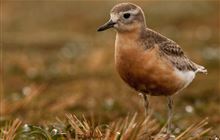Tread lightly for the tūturiwhatu / banded dotterel
Archived content: This media release was accurate on the date of publication.
Introduction
One of Hawke’s Bay’s smallest birds, the tūturiwhatu / banded dotterel, needs extra awareness during their most vulnerable time of year.Date: 13 September 2019
It is breeding season for all sorts of shorebirds in Hawke’s Bay / Te Matau a Māui, including the tūturiwhatu. From September, pairs of dotterels begin establishing nest sites and laying eggs. Chicks will start hatching in from mid-September onwards.
Dotterels often nest on the foreshore of beaches just above the high-water mark. They use camouflage and remain well-hidden unless disturbed. They are so well hidden that it’s easy to overlook them, which is their main defence from predators. However, this also leaves them especially vulnerable to disturbance.
DOC is working with locals, Hastings District Council and Napier City Council to increase awareness of the vulnerability of dotterel and other nesting shorebirds during the annual breeding season. Locals at Bayview and Westshore are particularly keen visitors are aware of this unique little bird.
“Many visitors to Bayview and Westshore simply aren’t aware that these tiny birds are nesting, often right in the beach area, they’re visiting. Once they are aware most people take much more care,” Paddy Cooper, a Bayview resident, says.
The main threats to tūturiwhatu, listed as Nationally Vulnerable, come from predators such as rats, mustelids and cats, and human activity. This includes vehicles in beach areas and uncontrolled dogs.
“Keeping vehicles such as quads or 4WDs away from nesting sites and below high-water mark is one way of reducing the likelihood of driving over nests and squashing eggs or chicks,” says Bernie Kelly, a Department of Conservation (DOC) ranger and member of Birds NZ.
“Dog owners need to be aware that wandering dogs in coastal areas are a very real threat to nesting shorebirds and other wildlife. Dogs can find and sometimes harass and kill nesting birds or chicks. Keeping dogs on lead is the best option.”
Helping these birds through their breeding season means taking care when visiting potential nesting sites right around Hawke’s Bay, he says.
“We’re lucky we have a significant population of dotterel here in the Hawke’s Bay. But given the national threat status of dotterel it’s important we take every opportunity to protect nesting sites, and not only on coastlines but also braided river beds in the district.”
Contact
For media enquiries contact:
Email: media@doc.govt.nz

